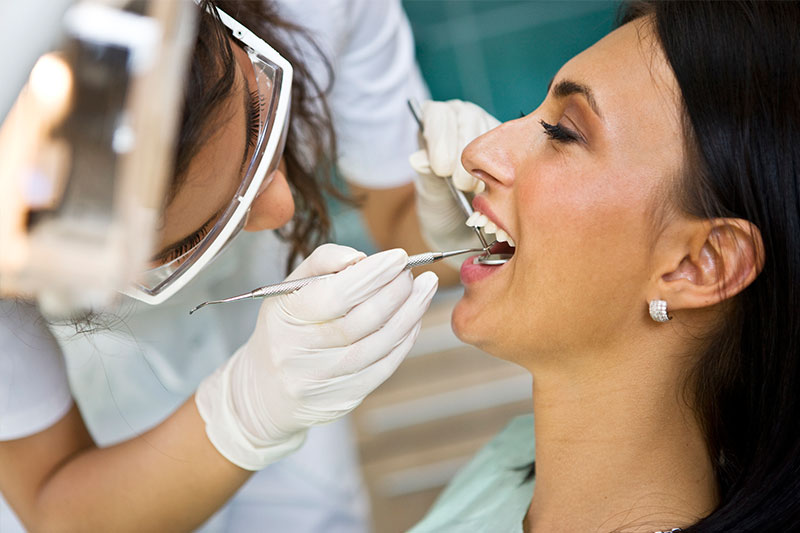Tag: dental crowns near me
What to Expect with Dental Crowns in Litchfield MN
When it comes to repairing a cracked, chipped, or fractured tooth, dental crowns are the most common treatment option, except in few cases where dental fillings may be used for minimal tooth damage in the front teeth.
One key difference between dental crowns and fillings is that the latter draw their strength from the tooth, whereas crowns strengthen the tooth by enclosing it with a cap. Depending on the extent of damage, a well-placed filling may last between 5 and 15 years, whereas a dental crown should last a lifetime. In general, if more than 50% of the tooth is damaged, then a crown should be placed. If a filled tooth continues to deteriorate, then it can be strengthened by a crown.
Your dentist may recommend dental crowns to address the following problems:
- Decay – that has affected more than half the tooth, such that a filling cannot be used
- To strengthen the tooth structure following root canal therapy
- Broken or fractured teeth
- To replace large fillings
- To fix chips and cracks
- To close small gaps between teeth
- To support dental bridges when replacing missing teeth
Living with a Dental Crown
Crowns are intended to last a lifetime, which means that they are made from tough and durable materials that are also wear and stain-resistant. That said, the exposed section of your natural tooth – that has not been enclosed by the tooth cap – is still susceptible to decay if you don’t exercise good oral hygiene. It’s important that you brush and floss your teeth every day, and visit the dentist every 6 months for professional cleanings to ensure optimal oral health.
Just as the crown material is stain resistant, it also cannot be bleached. So if you plan on whitening your teeth, your dentist may recommend that you start with it. This way, the shade of your crown can be selected based on the color of your new, sparkling white smile to create a uniform look.
To learn more about dental crowns and whether they’re good for you, please schedule a consultation with your dentist.
Dental Crown Procedure in Litchfield MN
One of the most frequent dental restorations and cosmetic procedures is the crown. A damaged and weakened tooth, which has been severely traumatized or decayed, is held together by this strong and durable cap, thus saving a tooth that might otherwise be extracted. Other advantages of crowns include:
Other benefits of tooth crowns include:
Avoiding Tooth Loss
The crown protects the remaining natural tooth so you are not forced to extract it. Crowns can be used to save decayed teeth, where the cavity has formed on more than 50 percent of the tooth, such that a filling cannot be used. To save the tooth, the dentist needs to remove the decay, clean the site, and cement the custom crown in place, restoring the complete function of your mouth.
Saving Your Damaged Teeth
Severe tooth damage usually requires a crown, because other forms of treatment are inadequate to restore the tooth. Some of the common applications of crowns include:
- To strengthen the tooth structure following root canal therapy
- To repair broken or fractured teeth
- To replace large fillings
- To fix chips and cracks
Cosmetic Restorations
If saving your tooth is critical, your dentist may suggest tooth-colored materials so that the restored tooth blends in with the other teeth. Because tooth-colored materials reflect light in the same manner as natural teeth, it is difficult to distinguish between tooth enamel and a restoration. This allows you to both restore and improve your smile.
If you have any questions or concerns about dental crowns, please visit your dentist today.
Common Questions About Dental Crowns in Litchfield MN
Crowns are one of the most popular restorative and cosmetic treatments in dentistry. They provide a strong and durable cap that holds together a tooth that has been severely damaged and weakened by trauma or decay, helping to save a tooth that may otherwise have been extracted.
Other benefits of tooth crowns include:
1. Prevent Tooth Loss from Decay
The crown protects the remaining natural tooth so you are not forced to extract it. Crowns can be used to save decayed teeth, where the cavity has formed on more than 50 percent of the tooth, such that a filling cannot be used. To save the tooth, the dentist needs to remove the decay, clean the site, and cement the custom crown in place, restoring the complete function of your mouth.
2. Save Damaged Teeth
Crowns are typically recommended for severe tooth damage, where other options are not sufficient to provide a strong restoration. Some of the common applications of crowns include:
- To strengthen the tooth structure following root canal therapy
- To repair broken or fractured teeth
- To replace large fillings
- To fix chips and cracks
3. Cosmetic Repairs
If dental crowns are the only way to save your tooth, your dentist may recommend tooth-colored materials so the restored tooth is barely noticeable compared to adjacent teeth. In fact, tooth-colored materials reflect light just like natural teeth, which makes it hard to distinguish the restoration from tooth enamel. This allows you to both restore and improve your smile.
If you have any questions or concerns about dental crowns, please visit your dentist today.
Dental Crowns FAQs – Litchfield MN
A dental crown, also known as a tooth cap, is used to strengthen a tooth’s structure, return its normal size, shape, and function, and/or improve its appearance. A tooth crowned fully covers the visible part of the tooth above the gum line, resulting in a new outer surface.
Common Applications of Dental Crowns
A dental crown is a permanent tooth repair option that can be used to restore different kinds of dental damage, including:
- Missing tooth – can be used to support bridgework or paired with a dental implant
- Large cavity that would otherwise require a large filling
- Weakened tooth due to excess wear or cracks – to support and protect the remaining structure
- Decayed tooth – can be used to strengthen a tooth restored with root canal therapy
- Poorly shaped or severely discolored tooth – to conceal the imperfection and improve your smile
Tooth Colored Dental Crowns
A dental crown, also known as a tooth cap, is used to strengthen a tooth’s structure, return its normal size, shape, and function, and/or improve its appearance. A tooth crowned fully covers the visible part of the tooth above the gum line, resulting in a new outer surface.
The most natural tooth appearance can be achieved with tooth-colored crowns, which blend in with your natural teeth to make the repair unnoticeable, resulting in an even, white smile.
To learn more about dental crowns and whether they’re right for you, please schedule a visit with our office.
Dental Crown Specialist Near Me in Litchfield MN
A dental crown or tooth cap can be used to fix chipped, cracked, or broken teeth. Fillings may be used to repair minor tooth damage in some instances. Crowns are preferable to fillings unless the damage is minor and limited to the front teeth. Fillings are less expensive than crowns, but they are not as strong unless the damage is minimal. Otherwise, crowns are preferred.
Crowns can be successfully used to treat various dental problems, including:
- Decay – that has affected more than half the tooth, such that a filling cannot be used
- To strengthen the tooth structure following root canal therapy
- Broken or fractured teeth
- To replace large fillings
- To fix chips and cracks
- To close small gaps between teeth
- To support dental bridges when replacing missing teeth
What’s the Process For A Dental Crown?
Dental crowns are one of the most popular dental restoration procedures for people of all ages, as most people are good candidates for them. Cosmetic improvements to damaged teeth can also be accomplished using tooth caps.
During your initial consultation, the dentist will examine your teeth to determine if you are a good candidate for dental crowns. The treatments starts by numbing the damaged tooth and surrounding gum tissue. Then, depending on the type of damage, any decay will be removed and the site thoroughly cleaned and disinfected in preparation for placing the filling material in the cavity. The dentist will also take digital impressions that will be used to create your custom crown, making sure to match the color of your crown to that of your teeth, or use a different shade if you wish to improve the appearance of your teeth and smile.
Contact Your Dentist Today
Please contact your dentist today to learn more about dental crowns and other dental restorative options that can work for you.
Dental Crowns Near Me, Litchfield MN
Dental Crowns are one of the most popular restorative and cosmetic treatments in dentistry. They provide a strong and durable cap that holds together a tooth that has been severely damaged and weakened by trauma or decay, helping to save a tooth that may otherwise have been extracted.
When Are Dental Crowns Used?
Dental crowns can be used to repair a variety of dental damage, including:
- Missing tooth – can be used to support bridgework or paired with a dental implant
- Large cavity that would otherwise require a large filling
- Weakened tooth due to excess wear or cracks – to support and protect the remaining structure
- Decayed tooth – can be used to strengthen a tooth restored with root canal therapy
- Poorly shaped or severely discolored tooth – to conceal the imperfection and improve your smile
If you’re planning on getting a dental crown, then you should try to learn as much as you can about this versatile treatment before scheduling your dental visit. Although your dental team can provide the information you need, educating yourself about the procedure will allow you to ask the right questions to ensure that the results you get are exactly what you wanted.
Tooth Colored Dental Crowns
Tooth-colored crowns will give you the most natural tooth appearance because they blend in with your natural teeth and make the repair unnoticeable, producing an even, white smile.
To learn more about dental crowns and whether they’re right for you, please schedule a visit with our office.
Dental Crowns Treatment in Litchfield MN
Dental crowns are custom-made tooth restorations that are designed to cap the entire surface of a weakened tooth in order to strengthen it. Dental crowns are permanent. As such, they’re carefully designed using impressions of the damaged tooth to ensure that the size and shape of the crown matches that of the original natural tooth. You can even choose tooth-colored materials for fabrication of your custom crown so it blends in with the surrounding, natural teeth.
The commonly used materials for tooth-colored crowns are porcelain and composite resin. However, you may also choose metal crowns made from gold, silver, or nickel/chromium alloys, or even choose a blend of porcelain and metal to take advantage of the properties of each material. During your visit, your dentist will help you determine the best choice of material depending on:
- The location and function of the tooth
- The visibility of the tooth when smiling
- The position of your gum line and gum tissue
- The shades of surrounding teeth
- Signs of teeth clenching and grinding
The crown that you choose will be placed in a number of steps undertaken within two appointments:
Step 1: Tooth Preparation
On your first visit, the dentist will administer a local anaesthetic to numb your face and prevent you from feeling any pain when preparing your tooth. Tooth preparation involves the removal of any decay and infection on the site, after which the tooth is filed down to maximize the retention of the crown and to ensure a good fit that doesn’t distort your smile.
Step 2: Making an Impression for the Dental Lab
After tooth preparation, a mold or impression of the tooth will be made and sent to the lab to fabricate your permanent custom crown. An impression of the opposing tooth may also be created to ensure a perfect fit with the mouth closed. Impressions are created using putty or paste that is spread over the prepared tooth and then pulled away so it keeps the shape of the tooth involved. The dentist can also note down specific details about the replacement tooth, such as the natural shade and fit, so its unnoticeable when you smile.
Step 3: Fitting a Temporary Crown
To protect the prepared tooth, a temporary or transition crown will be placed on it. This crown is typically made from plastic material (acrylic), and is held in place using a temporary cementing medium to allow easy removal at your next visit. During this period, it’s important to maintain proper oral hygiene at home to prevent reinfection of the tooth or gum tissues, which may affect the overall success of your crown treatment.
Step 4: Fitting the Permanent Crown
On your second scheduled visit, which should be in two to three weeks from the first visit, the dentist will remove the temporary crown and clean off the temporary cement from the prepared tooth. The permanent crown will then be fitted and adjusted for any bite variations. The dentist will check for accuracy and assess the aesthetics. If there are no issues, the crown can be cemented to your tooth.
Caring for Your Dental Crowns
Dental crowns should last a long time with proper care. Please discuss with your dentist about how to care for your teeth to protect the restoration and your other teeth from future damage.
To ask about Dental Crowns in Litchfield MN please contact us today.
Do I Need Dental Crowns? Litchfield MN
In dentistry, a crown refers to the surface area of the portion of the tooth above the gum line that is covered by enamel. In the event that this layer gets damaged due to decay, chips, fractures, or deep stains, your dentist may recommend that you get an artificial dental crown to fix the problem.
Crowns can be made from tooth-colored materials such as porcelain and composite resin, metals such as gold, silver, and nickel/chromium alloys, or a fusion of porcelain and metal to combine the benefits of each type of material. Your custom-made crown or cap will be permanently bonded to the damaged tooth in order to restore its natural shape, size, strength, function, and appearance (for tooth-colored crowns).
But Should You Get a Dental Crown?
Dental crowns are used to either restore the function of a damaged tooth, or to improve its appearance. There are other treatments that can be used to address the same issues, so your preference may not necessarily be dental crowns. Moreover, if you’re not in pain from decay or tooth damage, you may not need to seek urgent treatment yet, provided the tooth is still functional.
That said, there are several dental issues that may require treatment with dental crowns, including:
- A chipped, broken, or fractured tooth that is sensitive to hot and cold foods and drinks
- Weakened filling
- Very large cavities
- To strengthen and improve appearance of restored tooth after root canal therapy
- To support bridgework – the artificial tooth is bonded to the adjacent teeth through dental crowns so it stays suspended in the gap
- To replace teeth with dental implants – a crown is connected to the post implanted in the jawbone via an abutment, becoming your replacement tooth
- To correct cosmetic dental issues such as excessively or unevenly worn down, badly shaped or misshapen teeth, severely stained teeth, and widely gapped teeth
- To protect primary teeth (baby teeth) for children at high risk for tooth decay
Learn More About Dental Crowns
Depending on your specific case, your dentist will help you choose the most appropriate material for your custom dental crowns, restoring the function and appearance of your mouth.
To learn more about Dental Crowns in Litchfield MN please contact us today.
Types of Dental Crowns in Litchfield MN
Dental crowns or caps are a common dental prosthesis used to restore decayed, damaged, or missing teeth. When repairing a tooth with dental crowns, the dentist has to first file down the decayed or damaged tooth structure so it can accommodate the dental crown without it being over size as this could affect your bite. Dental impressions of the prepared tooth are then taken and sent to a dental laboratory to aid in fabricating your custom permanent crown.
There are different materials that can be used to fabricate the crown, including:
All Porcelain
This is a tooth-colored material that gives the restoration a natural look, which makes them a popular choice for repairing front teeth in order to preserve the aesthetics of your smile.
All-Resin
Dental composite resin is another tooth-colored material that can give you an aesthetic restoration. All-resin materials don’t contain any metals. They are highly affordable, but are arguably the weakest material for crowns since they’re prone to chipping, cracking, and rapid wear.
Metal
Crowns made from metal are the strongest and most durable option, plus they’re not abrasive to opposing teeth like all-porcelain. This makes them a suitable choice for back teeth. Different metals can be used to fabricate crowns, including gold, platinum, stainless steel, copper, and alloys like nickel-chromium and cobalt-chromium. Stainless steel crowns are typically used for temporary applications, like for the repair of primary teeth for children.
Porcelain-Fused-to-Metal
These crowns are generally fabricated with a metal base and porcelain coating, which gives them the strength of metal crowns and the aesthetics of tooth-colored crowns. However, porcelain-metal crowns tend to be abrasive to opposing teeth, which increases their wear rate. The metal ring on the crown may also become visible in the event of gum recession.
Zirconium
This is a fairly new dental material that produces crowns that are as strong and durable as metal crowns and natural-looking for an aesthetic restoration. As a result, zirconia crowns have become increasingly popular. Another advantage is that they’re biocompatible, and won’t cause allergic reactions. Additionally, Zirconia crowns can be fabricated at the dentist’s office for same-day crown restorations.
The Right Material for Your Dental Crown
Each dental crown material has various pros and cons that should be carefully evaluated before choosing your permanent crown restoration. Your dentist will help you make the right choice based on your specific dental needs.
To learn more about Dental Crowns in Litchfield MN please contact us today.
Dental Crowns – Your First Visit | Litchfield MN
Dental crowns can be fabricated from different materials that include porcelain, composite, porcelain-fused-to-metal, and different types of metals and alloys. Each type of crown has its unique pros and cons, so your dentist will help you choose the most appropriate one for your case depending on the strength requirements and aesthetic concerns of the tooth involved, as well as your personal preferences or allergic reactions to any of the materials.
Crowns are fabricated in a dental lab, so you will need to visit the dentist at least twice: the first time is to prepare your teeth and take measurements that will be used to prepare the crown, which can then be fitted on your second visit.
Here’s what to expect:
- On the first visit, your dentist will administer a local anaesthetic to numb your face for the duration of the procedure.
- Tooth preparation depends on your specific case, and may involve the removal of any decay and infection and filing down the tooth to maximize the retention of the crown and to ensure a good fit that doesn’t distort your smile.
- Next, a mold or impression of the tooth will be made and sent to the lab to fabricate your permanent custom crown. An impression of the opposing tooth may also be created to ensure a perfect fit with the mouth closed.
- To protect the prepared tooth, a temporary or transition crown will be placed on it. This crown is typically made from plastic material (acrylic), and is held in place using a temporary cementing medium to allow easy removal at your next visit.
- After two to three weeks you will return for fitting of the permanent crown. The dentist will remove the temporary crown and clean the site. The permanent crown will then be fitted and adjusted for any bite variations. If there are no issues, the crown can be cemented to your tooth.
Same-Day Crowns
It is possible to get your permanent crown prepared and installed on the same day, as is the case for zirconia crowns. The tooth is prepared the normal way. But instead of making an impression of the tooth, the dentist uses a wand scanner to capture pictures of the teeth. The images are uploaded into a computer where CAD software (computer-aided design) is used to design a 3D model that can be used to fabricate a replacement ceramic crown in about 15 minutes.
Restore Damaged Teeth Today
If you have a severely weakened tooth due to fractures, decay, or any other kind of damage, please visit your dentist to discuss whether crowns are suitable to restore the integrity of the tooth.
To ask about Dental Crowns in Litchfield MN please contact us today.

New Patient Exam Xrays and Regular Cleaning $67
Includes consultation, exam, and x-rays. In the absence of periodontal disease. New Patients Only
Make Appoinment
6 Month Smiles
Six Month Smiles is a short term orthodontic treatment that involves wearing clear braces to straighten and improve tooth alignment. This alternative treatment is a convenient approach to a straighter smile without the time commitment.
Learn more










